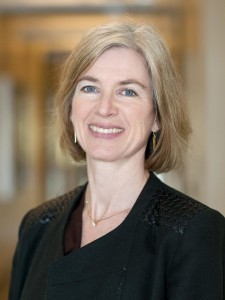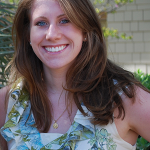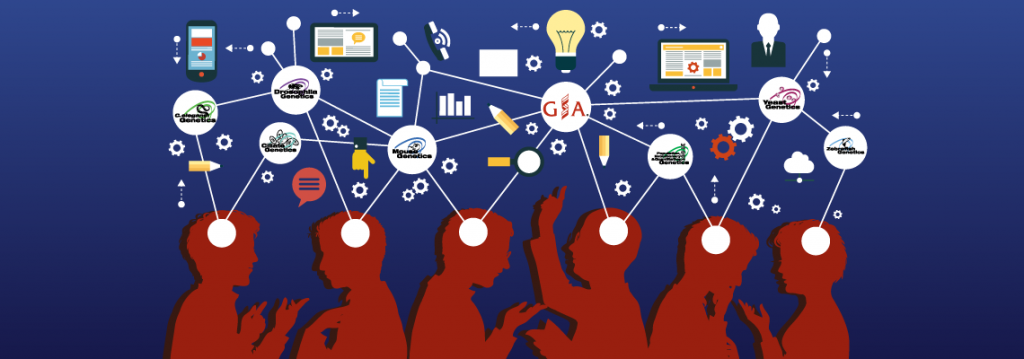In preparation for The Allied Genetics Conference (TAGC), set to take place in Orlando this July, Genes to Genomes is getting the inside scoop from many of the outstanding keynote speakers in our “Behind the Podium” series. Here, GSA member Maria Sterrett speaks with Jennifer Doudna, the bacterial immunity researcher who is now famous for her contribution to the development of the CRISPR/cas9 system for genome editing.

Dr. Jennifer Doudna
She almost needs no introduction. An esteemed researcher, innovator, and discoverer, Dr. Jennifer Doudna can definitely classify as a “rock star” in today’s modern scientific community. As a professor of Biochemistry and Molecular Biology and an HHMI investigator at the University of California, Berkeley, Doudna’s work has focused on understanding the molecular basis for evolution by studying the function of RNA molecules in cells. “I’ve always sort of been interested in fundamental questions in biology, but I’m also very excited to find ways for those fundamental insights to have real impact in human health and world problems,” Dr. Doudna told me on a recent afternoon. Indeed, it is from these fundamental questions that the newest hit of molecular technology emerged—CRISPR.
In 2012, Doudna and collaborators first demonstrated the gene editing power of Cas9 and the bacterial immune system. Since then, the technology has exploded, tested in nearly every model organism, and dubbed the biggest molecular technology since PCR (Ledford, 2015). Yet when I spoke with Dr. Doudna about her relationship with science and the scientific community, her responses resonated with passion, collaboration, and engagement that can only be defined as inspirational and encouraging for not only the current community, but for future research pioneers.
Dr. Doudna will be a keynote speaker at The Allied Genetics Conference (TAGC) this summer. “I think [it will be] a great meeting where geneticists as well as people like me that are not really geneticists, but have interest in the broad topics that will be discussed, come together.” She noted that TAGC will offer an “intersection between genetics and lots of other areas of science” and offer the opportunity for researchers to make connections across traditional field and organism boundaries.
Although she is more of a biochemist than a geneticist, Doudna, stressed the importance of societies like GSA: “[The GSA] is important to foster a great community of scientists to exchange ideas. I think [it] is also really important for encouraging younger scientists to get involved in the field and to explain the types of advances that are being made.”
Doudna noted the importance of scientists catching the research bug early. “Certainly my experience as an undergraduate in college [was a formative training experience],” Doudna recalled. “Having the opportunity to work for the summer in a biochemistry lab was very important [and] critical to help me understand what it’s like to work in a lab. I totally loved it.” Now a PI, Doudna said “I really feel privileged to be working with a wonderful group of students and postdocs who are in my lab, passionate about science, and are interested in doing creative work together…that’s been really fun and I’m always learning new things from them.”
“I love the process of discovery,” Doudna states, as well as the opportunity to work collaboratively. “I think for me science doesn’t happen in a vacuum,” she elaborated. “It’s very much a social endeavor that’s done with colleagues, and students of course, and postdocs.”
In her keynote address, Doudna plans to discuss how bacterial immunity research led to “a technology of genome editing and what that means for the future of genetics.”
Doudna may also advocate for engagement outside of the field—between scientists and the public. “I think [doing] very simple things, learning how to explain your science to non-scientists, how to talk about it using non-technical terms, how to explain what the significance is of the work you’re doing—like why do we care?— and always having a short two or three sentence spiel at the ready so when you’re sitting on an airplane and your seatmate says ‘so what do you do?’ you can say ‘I’m doing X.’ I think that would go a long way.” Engaging with a neighbor or with friends and family are informal encounters that can be the catalyst for change within the greater community. “If all of us as scientists do that regularly with our non-scientist friends, I think many more people would appreciate what scientists do.”

Maria Sterrett is a research associate at Indiana University studying sugar metabolism in Drosophila. From working with C. elegans in her undergraduate career to flies in her current position, Maria has had many experiences with the GSA and she is very much looking forward to the collaborative bonanza that will be TAGC this summer!













